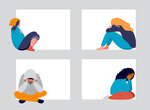


This month’s Chamber Forum on Mental Health was sad, informative and hopeful. I will share highlights of the 3 presentations, including some important ‘FYIs’ and ‘What You Can Do’s’.
Important acronyms used in this column and mental health jargon:
MH = mental health
BH = behavioral health
SMI = serious mental illness
SUD= substance abuse disorder
Psychiatrist Keith Brown, M.D. Medical Director of Thurston Mason Behavioral Health Administrative Service Organization, presented an overview.
It is a disturbance of one or more of thoughts or perceptions, mood, and/or behavior in which the symptoms create some degree of maladaptive function or impairment.
How common are these disorders in the US?
Common and on the rise in adults and children.
4.1% of adults have a SERIOUS MENTAL ILLNESS (schizophrenia and bipolar predominantly). 18.6% of adults have an MH disorder by the above definition, of which only 13.4% receive treatment. Substance abuse affects 8% of us age 12 and up.
Comorbidity is the rule, not the exception. You cannot separate the mind and the body.
18% of those with a MH disorder also have active SUD and 45% of those with SUD have a co-existing (or comorbid, as they say in the field) mental health disorder.
Usually, we don’t have just one thing. Similar comorbidities occur in physical health. One has heart disease and diabetes, nicotine addiction and blood flow restriction in the legs. These are comorbid conditions requiring treatment and like SUD and MH, one condition underlies the other. Additionally, MH disorders and SUDs are typically comorbid with physical health issues. This complicates MH treatment because the BH hospitals need the resources to treat MH patients who are physically ill.
Leslie Van Leishout, Director of Student Support for North Thurston Public Schools, presented with much-needed humor to fill us in on that question.
It is astounding what the schools are contending with.
Her district has a diverse student body of 15,000, of which 876 are homeless or in foster care. 25% considered suicide. Depression affects 40% of 8th to 10th graders. SUDs are rampant, with vaping a variety of substances being the most prevalent.
Let’s start with SUICIDE: a topic all 3 speakers addressed due to its prevalence and importance.
Suicide is not rare. I suspect most of you reading have known someone who has attempted or succeeded in suicide. These tragic circumstances are unforgettable, and the grief and guilt are often long-lasting. There is a suicide death in our country every 11 minutes, with 1.7 million attempts last year.
Suicide rates are highest in white males over 65. Men tend to use lethal means and ‘succeed.’ There is a second spike in suicides among youth ages 10-24 in which suicide is the second leading cause of death.
FIRST - Suicide Myths (that is, they are wrong):
SECOND - The stages of suicide:
THIRD – Warning Signs Acronym = FACTS
Suicide risk occurs in stages and there are often warnings. Paying attention to and intervening at any stage can prevent suicide. Any intervention to get a suicidal person help can prevent their death. Suicidal intervention is more effective than CPR, which has received a lot more press.
In 2020, US Congress designated the new 988 dialing code to be operated through the existing National Suicide Prevention Lifeline. The bill was signed into law in our state in July 2021. Abundant kudos to all involved in this collaborative effort to get this life-saving law passed nationally and in our state.
988 Lifeline is the 911 for Mental Health: “What You Can Do”
Calling 988 any time of day or night connects to free, confidential services for suicide prevention and/or to assist in a mental health crisis (that would include depression, psychosis, or dangerous behavior). The person suffering or a loved one may make the call for support and referral simply by picking up the phone.
Substance Abuse Disorders (SUDs) are in crisis proportions
What substances are we talking about? Alcohol, cocaine, amphetamines (including meth), cannabis, hallucinogens like PCP, sedatives, and the most common and serious being opioids (fentanyl and heroin).
Is there anyone reading who is or does NOT know a drug addict or alcoholic?
Fentanyl use and overdose deaths are rampant in Washington, where we tragically have the highest rate in the US. Why are so many people dying? Fentanyl is 100 x more potent than morphine. Heroin, no longer the primary street opiate, is only 2x more potent than morphine. A little bit of fentanyl can be deadly.
That is complicated but these are some key issues:
Mental Health Resources are strained and inadequate
Since 1950, one-third of state psychiatric hospital beds have closed. Where do the mentally ill now go? Emergency Departments, prisons, and homeless on the street in tents or RVs. Or DEATH- by suicide or overdose.
Might this fact have anything to do with our Emergency Department's crisis? You bet it does.
Nonetheless, there is hope and solutions are happening.
Psychiatrist Edward Case, M.D., Medical Director of South Sound Behavioral Health Hospital (SSBHH) was the 3rd speaker. He talked about resources and solutions.
SSBHH opened in 2019, our county’s first BHH with 108 beds currently expanding to 138 beds. Thurston County is three times more underserved for MH than King County. Our community will take every additional bed thank you!
SSBHH cares for adolescents and adults with all MH disorders, including SUDs. They offer programs in a variety of settings and intensities, inpatient and outpatient. Hospital admissions are predominantly for: SUD including detox and MAT (medically assisted treatment for opioid and alcohol use disorders), SMI (psychosis and bipolar mania or depression), and suicide attempts.
They offer free phone assessments 24/7 by calling them toll-free at 844-949-8888. We are glad they are here!
Additionally, around the large meeting room were booths set up by several dedicated professionals and non-profit organizations providing mental health treatment, resources, and care of all types. They ranged from Providence St. Peter’s Psychiatric Unit to cranial sacral therapy to psychedelic-assisted treatment interest groups and more.
Last but not least, our community abounds with 12-step groups that offer tools for recovery from SUDs and those affected by them, at no cost. The big three are Alcoholics Anonymous, Narcotics Anonymous, and Al-Anon (for friends and family of alcoholics and addicts). All have national and local websites with links to meetings available multiple times every day, locally and online.
The news is grim, but hope is real. Information is power. There is help. You can help yourself and others.
Debra L. Glasser, M.D., is a retired internal medicine physician in Olympia. Got a question for her? Write drdebra@theJOLTnews.com
Comments
No comments on this item Please log in to comment by clicking here